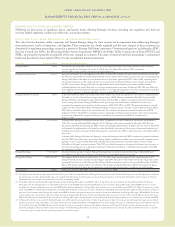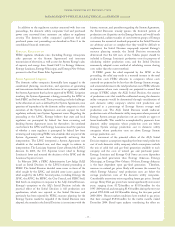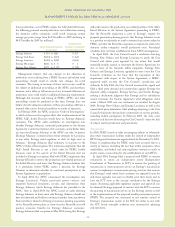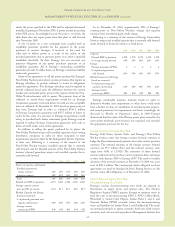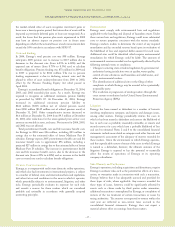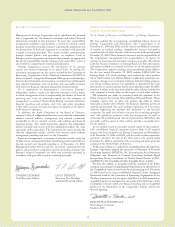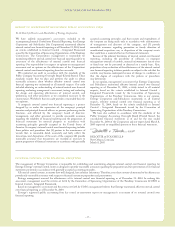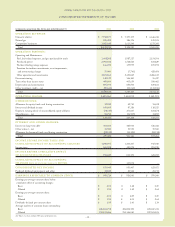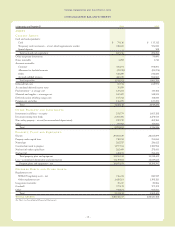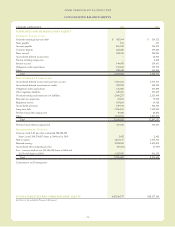Entergy 2004 Annual Report Download - page 43
Download and view the complete annual report
Please find page 43 of the 2004 Entergy annual report below. You can navigate through the pages in the report by either clicking on the pages listed below, or by using the keyword search tool below to find specific information within the annual report.
Entergy Corporation and Subsidiaries 2004
exposure of the various funds to market fluctuations will not affect
Entergy’s financial results of operations as it relates to the ANO 1
and 2, River Bend, Grand Gulf, and Waterford 3 trust funds
because of the application of regulatory accounting principles. The
Pilgrim, Indian Point 1 and 2, and Vermont Yankee trust funds
collectively hold approximately $952 million of fixed-rate,
fixed-income securities as of December 31, 2004. These securities
have an average coupon rate of approximately 5.4%, an average
duration of approximately 5.2 years, and an average maturity of
approximately 7.9 years. The Pilgrim, Indian Point 1 and 2, and
Vermont Yankee trust funds also collectively hold equity securities
worth approximately $450 million as of December 31, 2004. These
securities are generally held in funds that are designed to
approximate or somewhat exceed the return of the Standard &
Poor’s 500 Index, and a relatively small percentage of the securities
are held in a fund intended to replicate the return of the Wilshire
4500 Index. The decommissioning trust funds are discussed
more thoroughly in Notes 1, 8, and 15 to the consolidated
financial statements.
Nuclear Matters
The domestic utilitycompanies, System Energy, and Non-Utility
Nuclear subsidiaries own and operate ten nuclear power generating
units and the shutdown Indian Point 1 nuclear reactor. Entergy is,
therefore, subject to the risks related to owning and operating
nuclear plants. These include risks from the use, storage, handling,
and disposal of high-level and low-level radioactive materials,
limitations on the amounts and types of insurance commercially
available for losses in connection with nuclear operations,
and technological and financial uncertainties related to
decommissioning nuclear plants at the end of their licensed lives,
including the sufficiency of funds in decommissioning trusts. In the
event of an unanticipated early shut-down of any of Entergy’s
nuclear plants, Entergy may be required to provide additional
funds or credit support to satisfy regulatory requirements
for decommissioning.
Concerns are being expressed in public forums about the safety of
nuclear generating units and nuclear fuel, in particular in the
northeastern United States where Non-Utility Nuclear units are
located. These concerns have led to, and are expected to continue to
lead to, various proposals to federal regulators as well as governing
bodies in some localities where Entergy owns nuclear plants for
legislative and regulatory changes that could lead to the shut-down
of nuclear units, denial of license extension applications,
municipalization of nuclear units, restrictions on nuclear units as a
result of unavailability of sites for nuclear fuel disposal, or other
adverse effects on owning and operating nuclear power plants.
Entergy believes that its generating units are in compliance with
NRC requirements and Entergy vigorously responds to these
concerns and proposals.
Litigation
Entergy and its subsidiaries are involved in the ordinary course of
business in a substantial amount of employment, commercial,
asbestos, hazardous material, and other environmental and
rate-related proceedings and litigation. Entergy uses legal and
appropriate means to contest vigorously litigation threatened or
filed against it, but litigation poses a significant business risk
to Entergy.
CRITICAL ACCOUNTING ESTIMATES
The preparation of Entergy’s financial statements in conformity
with generally accepted accounting principles requires management
to apply appropriate accounting policies and to make estimates and
judgments that can have a significant effect on reported financial
position, results of operations, and cash flows. Management has
identified the following accounting policies and estimates as critical
because they are based on assumptions and measurements that
involve a high degree of uncertainty, and the potential for future
changes in the assumptions and measurements that could produce
estimates that would have a material effect on the presentation of
Entergy’s financial position or results of operations.
Nuclear Decommissioning Costs
Entergy owns a significant number of nuclear generation facilities
in both its U.S. Utility and Non-Utility Nuclear business units.
Regulations require Entergy to decommission its nuclear power
plants after eachfacilityis taken out of service, and money is
collected and deposited in trust funds during the facilities’
operating lives in order to provide for this obligation. Entergy
conducts periodic decommissioning cost studies (typically updated
every three to five years) to estimate the costs that will be incurred
to decommission the facilities. The following key assumptions have
asignificant effect on these estimates:
•Cost Escalation Factors -Entergy’sdecommissioning revenue
requirement studies include an assumption that
decommissioning costs willescalate over present cost levels by
annual factors ranging from approximately CPI-U to 5.5%.
A50 basis point change in this assumption could change the
ultimate cost of decommissioning a facility by as much
as 11.0%.
•Timing - In projecting decommissioning costs, two assumptions
must be made to estimate the timing of plant decommissioning.
First, the date of the plant’s retirement must be estimated. The
expirationof the plant’soperating license is typically used for
this purpose, or an assumption could be made that the plant will
be relicensed and operate for some time beyond the original
license term. Second, an assumption must be made whether
decommissioning will begin immediately upon plant retirement,
or whether the plant will be held in “safestore” status for later
decommissioning, as permitted by applicable regulations. While
the effect of these assumptions cannot be determined with
precision, assuming either license extension or use of a
“safestore” status can possibly change the present value of these
obligations. As discussed in Note 8 to the consolidated financial
statements, Entergy recorded revisions in 2004 to its estimated
decommissioning cost liability for four of its nuclear power
plants to reflect changes in assumptions regarding license
renewal. Increases in the probability of decommissioning the
plants at a date later than the original license expiration lowered
the estimate of the decommissioning cost liability. The changes
in probabilityfor the unregulated portionof Entergy Gulf
-41 -
MANAGEMENT’S FINANCIAL DISCUSSION and ANALYSIS continued





